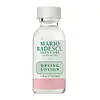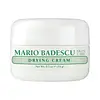What's inside
What's inside
 Key Ingredients
Key Ingredients

 Benefits
Benefits

 Concerns
Concerns

 Ingredients Side-by-side
Ingredients Side-by-side

Water
Skin ConditioningZinc Oxide
Cosmetic ColorantCetyl Alcohol
EmollientAloe Barbadensis Leaf Juice
Skin ConditioningCera Alba
EmollientPolysorbate 80
EmulsifyingGlycerin
HumectantEthylhexyl Palmitate
EmollientPropylene Glycol
HumectantSulfur
AntiseborrhoeicOleth-10
EmulsifyingParaffinum Liquidum
EmollientIchthammol
AntimicrobialHydrolyzed Yeast Protein
Skin ConditioningTriticum Vulgare Starch
AbrasiveArctium Lappa Root Extract
Skin ConditioningCysteine
AntioxidantNiacinamide
SmoothingPanthenol
Skin ConditioningNasturtium Officinale Flower/Leaf Extract
AntiseborrhoeicCitrus Limon Fruit Extract
MaskingAllantoin
Skin ConditioningBiotin
AntiseborrhoeicArginine
MaskingLeucine
Skin ConditioningLysine
Skin ConditioningTyrosine
MaskingValine
MaskingGlutamic Acid
HumectantCellulose Gum
Emulsion StabilisingPolysorbate 20
EmulsifyingMaltodextrin
AbsorbentZinc Chloride
AntimicrobialGlyceryl Acrylate/Acrylic Acid Copolymer
HumectantPyridoxine Hcl
Skin ConditioningParfum
MaskingSodium Chloride
MaskingMethylparaben
PreservativePropylparaben
PreservativePotassium Sorbate
PreservativeCitric Acid
BufferingSodium Benzoate
MaskingChlorphenesin
AntimicrobialDisodium EDTA
Phenoxyethanol
PreservativeBenzyl Benzoate
AntimicrobialAlpha-Isomethyl Ionone
PerfumingLimonene
PerfumingLinalool
PerfumingCI 77891
Cosmetic ColorantWater, Zinc Oxide, Cetyl Alcohol, Aloe Barbadensis Leaf Juice, Cera Alba, Polysorbate 80, Glycerin, Ethylhexyl Palmitate, Propylene Glycol, Sulfur, Oleth-10, Paraffinum Liquidum, Ichthammol, Hydrolyzed Yeast Protein, Triticum Vulgare Starch, Arctium Lappa Root Extract, Cysteine, Niacinamide, Panthenol, Nasturtium Officinale Flower/Leaf Extract, Citrus Limon Fruit Extract, Allantoin, Biotin, Arginine, Leucine, Lysine, Tyrosine, Valine, Glutamic Acid, Cellulose Gum, Polysorbate 20, Maltodextrin, Zinc Chloride, Glyceryl Acrylate/Acrylic Acid Copolymer, Pyridoxine Hcl, Parfum, Sodium Chloride, Methylparaben, Propylparaben, Potassium Sorbate, Citric Acid, Sodium Benzoate, Chlorphenesin, Disodium EDTA, Phenoxyethanol, Benzyl Benzoate, Alpha-Isomethyl Ionone, Limonene, Linalool, CI 77891
 Reviews
Reviews

Ingredients Explained
These ingredients are found in both products.
Ingredients higher up in an ingredient list are typically present in a larger amount.
Ci 77891 is a white pigment from Titanium dioxide. It is naturally found in minerals such as rutile and ilmenite.
It's main function is to add a white color to cosmetics. It can also be mixed with other colors to create different shades.
Ci 77891 is commonly found in sunscreens due to its ability to block UV rays.
Learn more about CI 77891Glycerin is already naturally found in your skin. It helps moisturize and protect your skin.
A study from 2016 found glycerin to be more effective as a humectant than AHAs and hyaluronic acid.
As a humectant, it helps the skin stay hydrated by pulling moisture to your skin. The low molecular weight of glycerin allows it to pull moisture into the deeper layers of your skin.
Hydrated skin improves your skin barrier; Your skin barrier helps protect against irritants and bacteria.
Glycerin has also been found to have antimicrobial and antiviral properties. Due to these properties, glycerin is often used in wound and burn treatments.
In cosmetics, glycerin is usually derived from plants such as soybean or palm. However, it can also be sourced from animals, such as tallow or animal fat.
This ingredient is organic, colorless, odorless, and non-toxic.
Glycerin is the name for this ingredient in American English. British English uses Glycerol/Glycerine.
Learn more about GlycerinSulfur is a commonly occurring element on Earth (and our universe!). In cosmetics, it helps kill bacteria, reduces sebum, and provides exfoliation. This makes it an effective ingredient to reduce breakouts and fight acne.
As a ketayolytic agent, it breaks down the top layer of skin. This is a form of exfoliation and may help decrease acne and hyperpigmentation.
Studies show sulfur has antibacterial and antifungal properties. Sulfur can be drying if used excessively or at higher concentrations. We recommend speaking with a medical professional if you have any concerns.
Ancient Greece, India, China, and Egypt have used sulfur in both traditional medicines and for household use.
Learn more about SulfurWater. It's the most common cosmetic ingredient of all. You'll usually see it at the top of ingredient lists, meaning that it makes up the largest part of the product.
So why is it so popular? Water most often acts as a solvent - this means that it helps dissolve other ingredients into the formulation.
You'll also recognize water as that liquid we all need to stay alive. If you see this, drink a glass of water. Stay hydrated!
Learn more about WaterZinc Oxide is a mineral broad-spectrum UV filter; it is the broadest UVA and UVB reflector approved by the FDA. It also has skin protectant and skin soothing properties.
Zinc oxide is one of the most effective broad-spectrum UV filters. It protects against UVB, UVAII, and UVAI. In comparison to its counterpart titanium dioxide, zinc oxide provides uniform and extended UVA protection.
Another great benefit? This ingredient is highly photostable so it won't degrade easily under sunlight.
A common myth is that mineral UV filters are widely believed to primarily reflect UV light.
However, modern research shows titanium dioxide absorbs UV radiation like chemical filters (~95% absorption & 5% reflection).
Zinc oxide has great skin soothing properties so you'll likely find this in sunscreens formulated for sensitive skin or babies/children. It is unlikely to cause "eye sting" like other sunscreen ingredients.
Regulatory agencies consider zinc oxide to be non-toxic and safe. It has also been shown to not penetrate the skin.
Unfortunately, this ingredient does leave a visible white cast. This is why mineral sunscreens are often less cosmetically elegant than chemical or hybrid ones.
In cosmetics, zinc oxide can be found in both non-nano and nano-sized forms. The nano version is used to reduce white cast and improve the texture of sunscreen formulas.
There are ongoing concerns surrounding nano-zinc oxide's impact on marine ecosystems and whether it can be absorbed into skin.
Regarding marine ecosystems and coral reefs, there is no conclusive evidence that any form of zinc oxide (or any other sunscreen ingredients) will cause harm. The science is still developing but many consumers are keeping a close eye on this issue.
Please note, many destinations have reef-safety sunscreen rules. For instance, the U.S. Virgin Islands advises all visitors to use non-nano mineral sunscreens.
There has also been some stir about whether micronized or nano zinc oxide has potential photoxicity and absorption through the skin/lungs.
An in-vitro (done in a test tube or petri dish) study demonstrated micronized zinc oxide to have potential phototoxicity. There's no need to fret; the EU Commission's Scientific Committee on Consumer Safety has stated, "The relevance of these findings needs to be clarified by appropriate investigations in vivo." Or in other words, further studies done on living organisms are needed to prove this.
Current research shows zinc oxide nanoparticles do not penetrate intact or sunburned skin. They either remain on the surface or in the outermost layer of dead skin (stratum corneum).
Zinc oxide is one of only two classified mineral UV filters with titanium dioxide being the other one.
Fun fact: Zinc has been used throughout history as an ingredient in paint and medicine. An Indian text from 500BC is believed to list zinc oxide as a salve for open wound. The Ancient Greek physician Dioscorides has also mentioned the use of zinc as an ointment in 1AD.
Learn more about Zinc Oxide